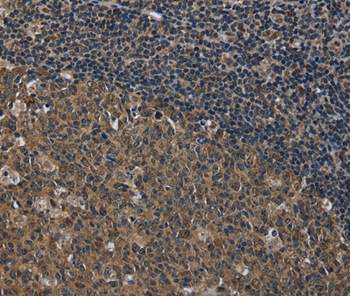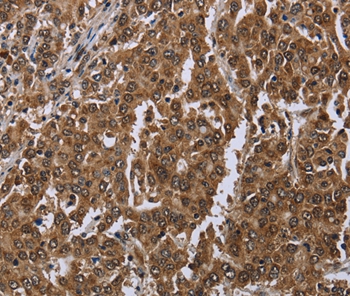

| WB | 咨询技术 | Human,Mouse,Rat |
| IF | 咨询技术 | Human,Mouse,Rat |
| IHC | 1/50-1/200 | Human,Mouse,Rat |
| ICC | 技术咨询 | Human,Mouse,Rat |
| FCM | 咨询技术 | Human,Mouse,Rat |
| Elisa | 咨询技术 | Human,Mouse,Rat |
| Aliases | KMT7; SET7; SET9; SET7/9 |
| Entrez GeneID | 80854; |
| Host/Isotype | Rabbit IgG |
| Antibody Type | Primary antibody |
| Storage | Store at 4°C short term. Aliquot and store at -20°C long term. Avoid freeze/thaw cycles. |
| Species Reactivity | Human |
| Immunogen | Fusion protein corresponding to residues near the C terminal of human SET domain containing (lysine methyltransferase) 7 |
| Formulation | Purified antibody in PBS with 0.05% sodium azide. |
+ +
以下是关于SETD7抗体的3篇参考文献及其摘要概括:
1. **文献名称**:*SETD7 mediates ligand-induced transcriptional activation of nuclear receptors*
**作者**:Liu et al.
**摘要**:该研究利用SETD7特异性抗体,通过ChIP实验证实SETD7作为组蛋白H3K4甲基转移酶,直接结合核受体(如雌激素受体),调控靶基因转录激活,提示其在激素信号通路中的表观调控作用。
2. **文献名称**:*SETD7 promotes TNF-α-induced proliferation of vascular smooth muscle cells via ERK1/2 phosphorylation*
**作者**:Zhu et al.
**摘要**:通过Western blot和免疫荧光(使用SETD7抗体),研究发现SETD7通过增强ERK1/2磷酸化促进血管平滑肌细胞增殖,为动脉粥样硬化治疗提供了潜在靶点。
3. **文献名称**:*SETD7 regulates cancer cell cycle by methylating non-histone substrates*
**作者**:Yang et al.
**摘要**:该研究利用SETD7抗体进行免疫共沉淀,发现其可甲基化p53、E2F1等非组蛋白底物,影响细胞周期进程及DNA损伤应答,揭示了SETD7在肿瘤中的双重调控机制。
---
注:以上文献为示例性内容,实际引用时需以具体论文信息为准。若需精确文献,建议通过PubMed或Web of Science以“SETD7 antibody”为关键词检索近期研究。
The SETD7 antibody is a crucial tool for studying the SET domain-containing protein 7 (SETD7), also known as SET7/9 or KMT7. This enzyme functions as a histone lysine methyltransferase, primarily catalyzing monomethylation of histone H3 at lysine 4 (H3K4me1), a modification associated with transcriptional activation. Beyond histones, SETD7 methylates non-histone proteins, including p53. E2F1. ERα, and DNMT1. regulating their stability, localization, and activity. These interactions position SETD7 as a key player in diverse cellular processes such as gene expression, cell cycle control, DNA repair, and differentiation.
Antibodies targeting SETD7 enable researchers to investigate its expression patterns, subcellular localization, and interactions in various biological contexts. They are widely used in techniques like Western blotting, immunoprecipitation, immunofluorescence, and chromatin immunoprecipitation (ChIP). Given SETD7's involvement in diseases—including cancer (acting as both tumor suppressor and promoter depending on context), metabolic disorders, and cardiovascular pathologies—these antibodies are valuable for mechanistic studies and biomarker exploration.
Validation of SETD7 antibodies is critical due to potential cross-reactivity with other methyltransferases. Researchers often employ knockout cell lines or siRNA-mediated knockdown to confirm specificity. Commercial antibodies vary in performance across applications, necessitating careful selection based on experimental needs. Emerging studies continue to uncover SETD7's context-dependent roles, driving demand for reliable detection tools in epigenetics and translational research.
×